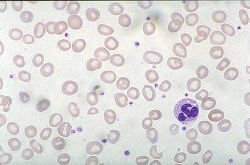- Introduction to anaemia
- Classification of anaemia
- Causes of anaemia
- Diagnosis of anaemia
- Treatment of anaemia
Introduction to anaemia

Haemoglobin is measured in terms of the weight present in grams (g) per 100 millilitres (1 decilitre or dl) of blood. A normal level in females will lie somewhere between 11.5 and 15.5 g per dl, and in males between 13 and 18 g per dl. The normal range of red cell numbers per cubic millimetre of blood is 4,100,000–5,200,000 in females and 4,400,000–5,800,000 in males.
Classification of anaemia
Anaemia is classified in terms of size of the red blood cells.
- In microcytic anaemia, the red blood cells are smaller than normal;
- In normocytic anaemia, they are of normal size; and
- In macrocytic anaemia, the red blood cells are larger than normal.
Causes of anaemia
There are a number of causes for each type of anaemia:
- Iron deficiency;
- Certain inherited blood diseases (e.g. thalassaemia);
- Anaemia occurring in chronic disease.
- Lack of Vitamin B12 or folate: Inadequate intake in diet or not being absorbed (due to bowel disease);
- Chemotherapy drugs;
- Liver disease/long term heavy alcohol use;
- Diseases of the bone marrow.
- Acute blood loss: Heavy periods, internal bleeding (e.g. from a stomach ulcer);
- Anaemia of chronic disease;
- Chronic renal failure;
- Endocrine disorders (e.g. low thyroid activity).
Diagnosis of anaemia
The evaluation of someone with anaemia begins with the doctor asking questions to ascertain the possible causes of the anaemia. This is usually followed by a careful physical examination.
Symptoms of anaemia are generally vague but may include:
- Fatigue;
- Muscle weakness;
- Headache;
- Inability to concentrate;
- Dizziness/fainting;
- Breathlessness on exertion;
- Palpitations (abnormal heart beats).
The answers to questions asked may indicate potential causes of anaemia:
- Iron deficiency: Poor iron intake, pregnancy, internal bleeding, heavy periods, use of anti-inflammatory or blood thinning medications;
- Folate deficiency: Inadequate diet, small bowel disease;
- B12 deficiency: previous bowel surgery, dietary factors.
Most cases of anaemia are mild, including those that occur as a result of chronic disease. Nevertheless, even mild anaemia can reduce oxygen transport in the blood, causing fatigue and a diminished physical capacity.
Moderate to severe iron-deficiency anaemia is known to reduce endurance. Iron deficiency anaemia is the most common type of anaemia. It affects up to 30% of the world’s population.
Megaloblastic anaemia (the red cells are megaloblastic i.e. large and abnormal) develops if vitamin B12 or folic acid are lacking. Another type of megaloblastic anaemia is called “pernicious” anaemia, in which there is insufficient absorption of vitamin B12 from the diet.
Haemolytic anaemia occurs as the result of an inherited or an acquired condition in which the body destroys red blood cells prematurely. Haemolysis describes the breaking up of red blood cells, resulting in the release of haemoglobin into the plasma.
Basic tests for anaemia include measuring the haemoglobin level, size of the red blood cells, and looking at the shape of characteristics of the blood cells (blood film).
Further tests ordered are based on clinical and physical findings. For instance if the bleeding is thought too originate from a gastrointestinal cause, appropriate investigations might include using instruments to look inside the bowel, biopsy (taking a sample from the bowel), and performing x-ray or scans.
Treatment of anaemia
Treatment should be directed at correcting the underlying cause of the anaemia (e.g. stopping any active bleeding). Dietary factors may also need to be addressed, such as eating iron and vitamin C rich foods, and foods rich in folate and B12. In severe anaemia, blood transfusions may be required.
Erythropoietin causes the production of red blood cells. Injections of erythropoietin may be necessary in patients with chronic renal failure, as they cannot make sufficient erythropoietin and hence develop anaemia.
Article kindly reviewed by:
The DAA WA Oncology Interest Group
and
Food4Health (Helen Baker Dietitian-APD)
Diseases presenting with anaemia include:
- Anaemia of Chronic Disease
- Iron Deficiency Anaemia
- Megaloblastic Anaemia
- Sickle Cell Anaemia
- Thalassaemia (Mediterranean anemia; Cooley’s anemia)
References
All content and media on the HealthEngine Blog is created and published online for informational purposes only. It is not intended to be a substitute for professional medical advice and should not be relied on as health or personal advice. Always seek the guidance of your doctor or other qualified health professional with any questions you may have regarding your health or a medical condition. Never disregard the advice of a medical professional, or delay in seeking it because of something you have read on this Website. If you think you may have a medical emergency, call your doctor, go to the nearest hospital emergency department, or call the emergency services immediately.







